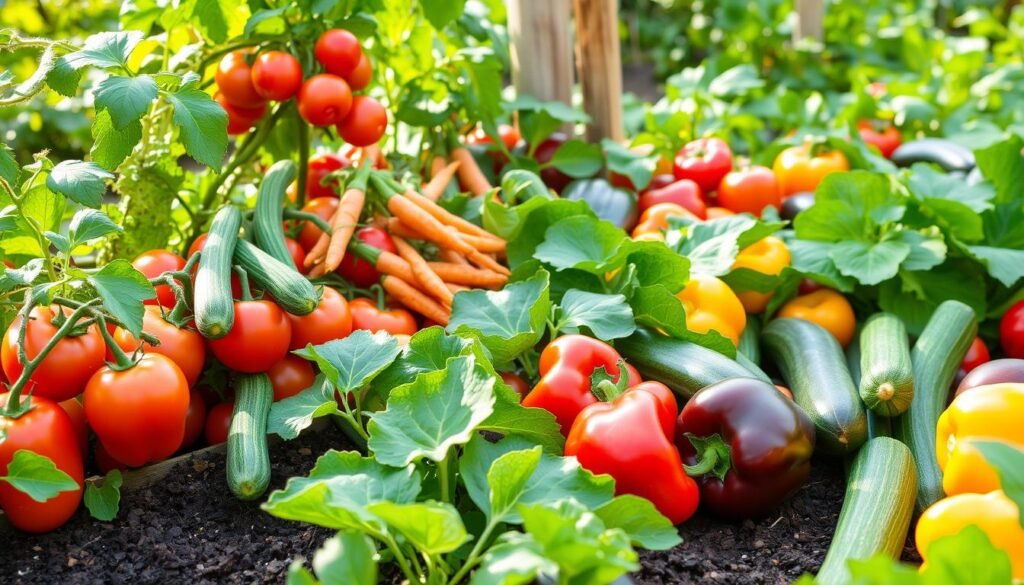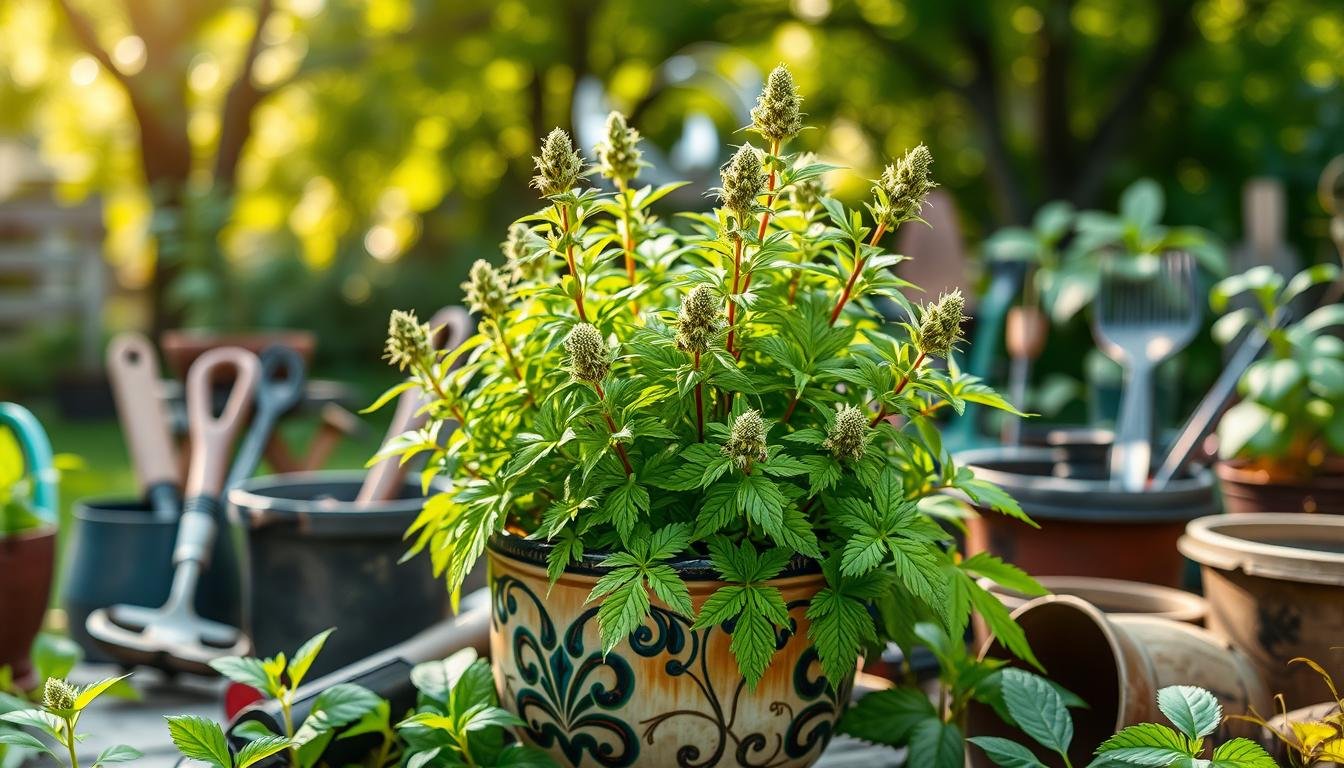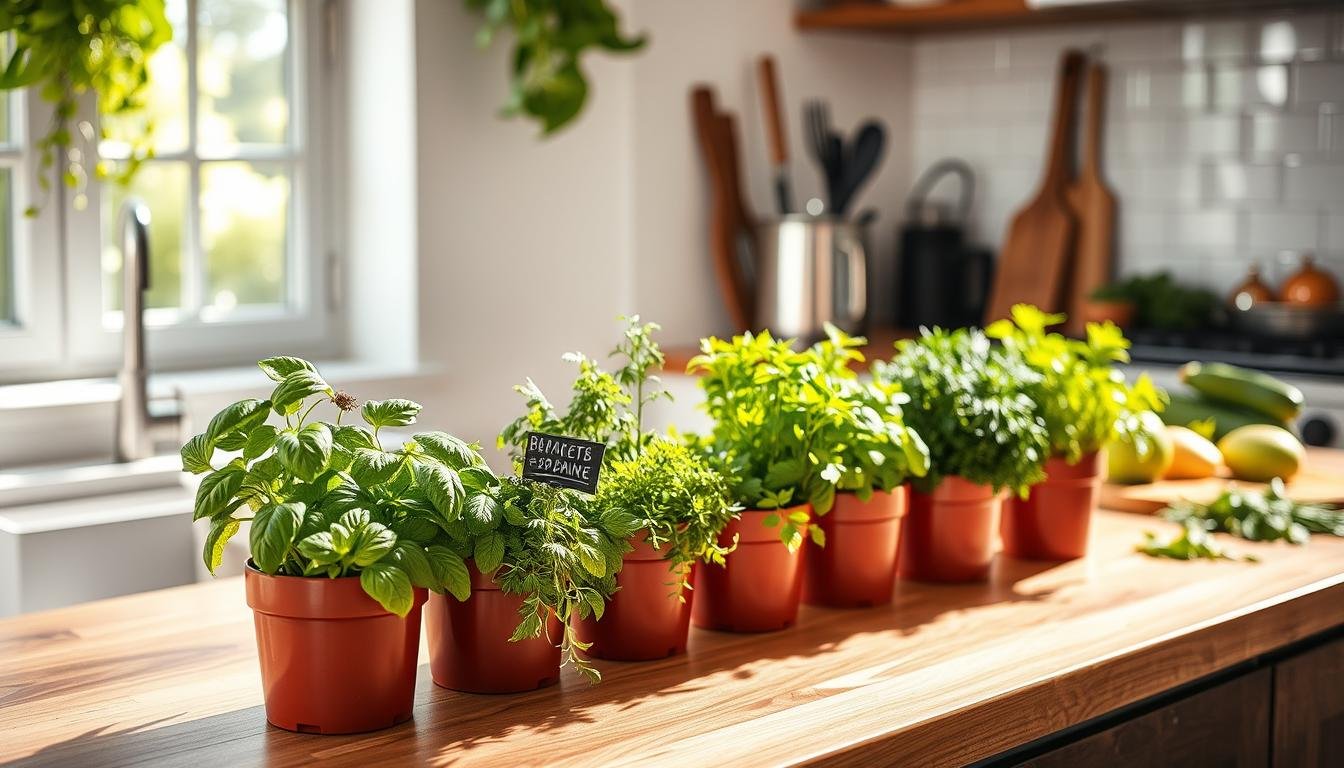Did you know almost 30% of U.S. homes now have a garden? People love growing veggies for fresh, tasty options. Picking veggies right from your backyard makes cooking more fun. It also helps you feel closer to what you’re eating.
If you’re experienced or just starting out, gardening has many perks. You’ll love the taste of fresh tomatoes. And, you’ll feel proud watching your plants grow. Let’s dive into a list of great vegetables for your garden.
Key Takeaways
- Growing your own veggies can save you money in the long run.
- Homegrown produce is often fresher and tastier than store-bought.
- Cultivating a garden promotes a sustainable lifestyle.
- Many vegetables are easy to grow, even for beginners.
- Gardening provides a rewarding outdoor activity that benefits mental health.
- Planting a variety of veggies can enhance biodiversity in your backyard.
Why Grow Your Own Vegetables?
Growing your own vegetables ups your quality of life and helps the planet. It lets you enjoy many benefits, like tasting a variety of flavors and getting more nutrition. Plus, there’s a true joy in eating food you’ve grown yourself.
Benefits of Homegrown Veggies
Homegrown veggies are special for a few reasons. They taste better than what you buy at the store. This means your meals can be more delicious. Also, they have more vitamins because you pick them when they’re perfectly ripe. Gardening makes you feel capable and ensures you’ve always got something to eat.
Environmental Impact of Growing Vegetables
Growing your own food has lots of good effects on the environment. It cuts down on the pollution from transporting groceries. This saves energy and creates a better place for bees and other helpful bugs. Making a vegetable garden helps nature and lets you enjoy your own fresh produce.
Essential Tools for Vegetable Gardening
Successful vegetable gardening starts with having the right tools. Essential tools make work easier and help your vegetable garden flourish. They help with everything from planting to keeping the garden healthy and harvesting.
Understanding how to use these tools well can make preparing your garden smoother and more fun.
Must-Have Gardening Tools
Every gardener should be prepared with a few key tools:
- Trowel: Great for digging small holes, moving soil, and transplanting seedlings.
- Pruners: Important for cutting back plants and encouraging them to grow well.
- Hand Fork: Helps to loosen the soil and take out weeds easily.
- Watering Can: Perfect for getting water right where it’s needed without waste.
- Garden Gloves: Keep your hands clean and safe from harm.
Preparing Your Home Vegetable Patch
Getting your garden ready for planting is crucial for good growth. First, test your soil to know what nutrients it has. This lets you fix any soil issues by adding compost or fertilizer. Doing these steps makes the soil rich and ready for your veggies.
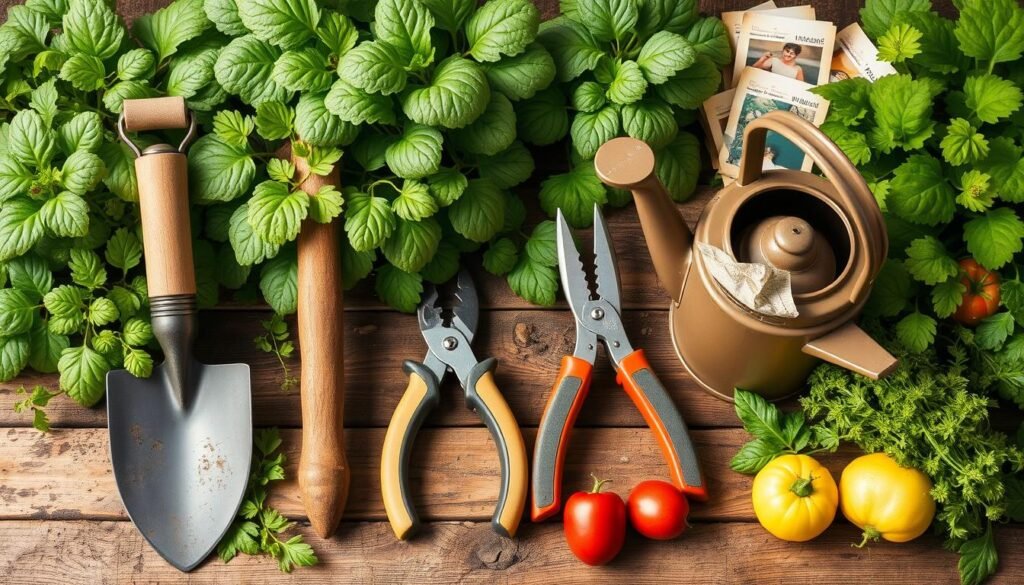
| Tool | Purpose | Benefits |
|---|---|---|
| Trowel | Digging and transplanting | Ensures proper plant placement |
| Pruners | Trimming plants | Helps plants grow better and bear fruit |
| Hand Fork | Loosening soil and weeding | Makes the soil healthier and airy |
| Watering Can | Watering plants | Gives you control over how much water plants get |
| Garden Gloves | Protecting hands | Keeps hands safe from cuts and dirt |
Most Popular Garden Vegetables List
Growing your own vegetables is both rewarding and fun. You get to pick from a lot of popular garden vegetables. These choices are not only healthy but also easy to grow. Here’s a list of top vegetables that beginner gardeners can easily add to their garden.
Top Picks for Easy Cultivation
Some vegetables stand out because they’re easy to grow and give back a lot:
- Tomatoes: They are versatile and tasty, doing well in warm weather either in pots or garden beds.
- Cucumbers: They grow fast and are low-maintenance, offering a refreshing taste.
- Bell Peppers: These colorful peppers are great for growing in containers.
- Lettuce: Perfect for quick harvesting, lettuce can thrive under various conditions.
- Radishes: Quick to sprout, radishes are crunchy and ideal for tight spaces.
Choosing the Right Veggie Varieties for Your Space
Picking the right vegetables for your garden involves a few considerations:
- Space: With little room, choose compact or container-friendly plants.
- Climate: Pick seeds that match your local climate. Some veggies like kale do well in cold, others in heat.
- Garden Layout: Think about using vertical spaces, like trellises for cucumbers, to save space and help plants breathe.
Setting Up Your Backyard Garden
Starting a backyard garden requires careful thought. Picking the right location is key to your garden’s success. The amount of sunlight, how the water drains, and having water close by are important. Once you’ve chosen the perfect spot, get the soil ready. Adding nutrients makes the soil ready for growing many types of vegetables.
Choosing the Right Location
Your garden needs a lot of sunlight, around six to eight hours a day. Stay away from places that are too shady, like under trees or beside buildings. It’s also important to have good drainage to keep plants from getting too wet. Being close to a water source helps with easy watering. A little slope in your garden can help with water flow and minimize puddles.
Soil Preparation and Fertility
First, check your soil with a test to see its pH and what nutrients it has. Vegetables do best in soil that is a bit acidic or neutral, with a pH between 6.0 and 7.0. Boost the soil by mixing in organic things like compost or old manure. This will make your soil richer and help plants grow better. Keep your soil loose so roots can spread out easily.
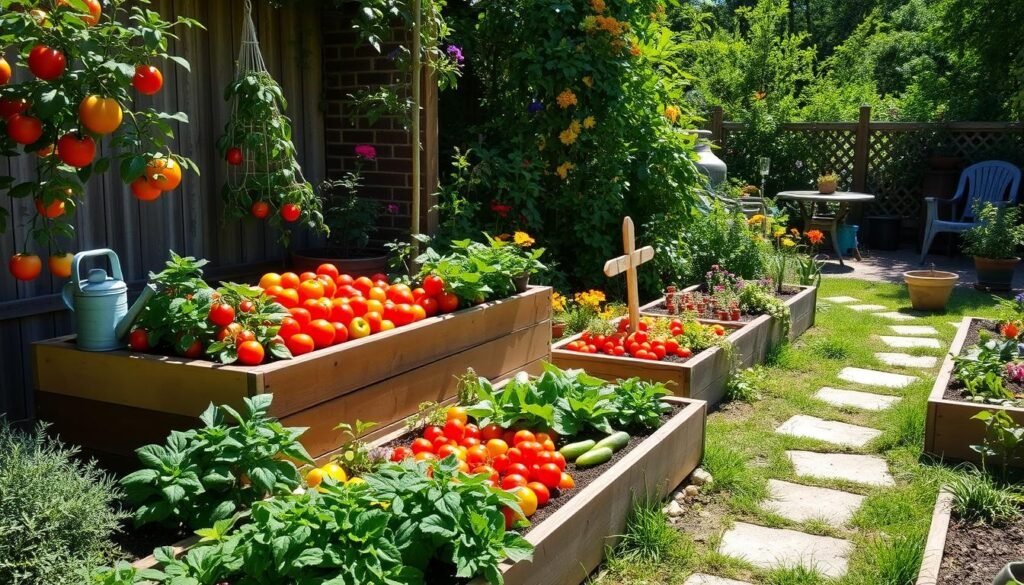
Growing Vegetables: Year-Round Options
Garden lovers, imagine growing veggies all year! Learning how to use each season makes your garden better. Fall and winter offer special advantages. On the other hand, spring and summer let you grow fresh and lively veggies.
Fall and Winter Vegetable Choices
When days get shorter and it cools down, some veggies do really well. Here are good choices for cold months:
- Kale – It grows quickly and doesn’t mind frost.
- Carrots – They get sweeter in the cold. Start in late summer for winter eating.
- Brussels Sprouts – Strong plants that taste better after a frost.
- Garlic – Plant it in fall to enjoy a big harvest next summer.
Spring and Summer Planting Guidelines
When spring arrives, it’s time to plan your garden. Keep these tips in mind:
- Set up your garden early, including different crops for rotation.
- Stagger your planting times to keep harvesting all season.
- Use companion planting to boost growth and keep pests away.
Adding these ideas to your garden routine helps you have fresh veggies all year. It takes some work, but growing veggies year-round is rewarding and fulfilling.
Edible Plants Beyond Traditional Vegetables
Adding new plants to your garden can shake things up. You’ll discover a whole new world of tastes. In this section, we’ll explore kitchen garden herbs and some fruit-bearing varieties. They can really change your garden game.
Herbs to Enhance Your Kitchen Garden
Herbs do more than just add flavor. They also make your garden look and smell amazing. Let’s check out some great kitchen garden herbs:
- Basil: Perfect for pestos and Italian meals.
- Cilantro: Key for salsa and Asian dishes.
- Parsley: It goes well in lots of recipes.
- Thyme: Ideal for meats and veggies.
- Mint: Makes drinks and desserts pop.
Fruit-Bearing Plants for Added Variety
Adding fruit-bearing varieties to your garden isn’t just fun. It gives you tasty snacks right from your backyard. Here are some top picks:
| Fruit-Bearing Plant | Growing Conditions | Harvest Time |
|---|---|---|
| Strawberries | Full sun, well-drained soil | Spring to early summer |
| Blueberries | Partial to full sun, acidic soil | Summer |
| Raspberries | Full sun, rich soil | Summer to fall |
| Tomatoes | Full sun, fertile soil | Summer to fall |
| Peppers | Full sun, well-drained soil | Summer |
Tips for a Successful Garden Harvest
Knowing when to pick your veggies is key for a great garden yield. The timing affects both taste and health benefits. Every vegetable shows when it’s perfect to harvest. Learning these signs and some simple harvesting tips can boost your garden’s success.
When to Harvest Your Vegetables
Vegetables tell you when they’re ready to be picked. Here’s what to watch for:
- Color: Vibrant colors mean they’re ripe.
- Size: They should be the right size.
- Firmness: They should be firm but not hard.
- Leaves: Look for healthy leaves.
For more detail, see these guidelines:
| Vegetable | Harvest Time |
|---|---|
| Tomatoes | When fully colored with a slight softness |
| Zucchini | When 6-8 inches long |
| Carrots | When the tops are about 1 inch in diameter |
| Bell Peppers | When they reach full size and color |
Best Practices for Storing Your Bounty
Proper storage is crucial after harvesting. These tips will keep veggies fresh longer:
- Cool Down: Cool veggies to room temp before storing.
- Moisture Control: Wash them only when ready to use.
- Containers: Use breathable containers for less moisture.
- Temperature: Keep in a cool, dark place.
Troubleshooting Common Vegetable Gardening Issues
Gardening brings its own set of challenges. Issues like pest attacks and diseases can bother gardeners. It’s vital to manage pests well and recognize diseases early. This makes your garden thrive. Here are ways to tackle these garden challenges.
Pest Management Strategies
Pests can seriously damage your plants if you don’t control them. We have some tips to help.
- Neem oil: This natural pesticide fights various pests and keeps good insects safe.
- Companion planting: Some plants together can naturally keep pests away. This helps keep your garden healthy.
- Regular monitoring: Always watch your plants for early signs of pests. Spotting them early can stop bigger issues.
- Physical barriers: Using covers or nets can shield your plants from pests.
Dealing with Plant Diseases
Quick action on plant diseases limits damage to your garden. Here are some important strategies:
- Know the symptoms: Learn about common diseases like blight or powdery mildew. Knowing them helps you act fast.
- Crop rotation: Moving your crops each year helps prevent diseases. This keeps the soil healthy.
- Healthy plants: Strong, well-fed plants fight off diseases better. Making sure they’re healthy is key.
- Sanitation practices: Clean your gardening tools and get rid of sick plants. This stops diseases from spreading.
Incorporating Backyard Produce into Your Meals
Using backyard produce can make daily meals exciting and tasty. Cooking with your own veggies boosts dish flavors and gives you lots of nutrition. It’s fresh and organic. These garden gems also make you get creative when cooking.
- Salads: Toss fresh greens, tomatoes, and cucumbers for a refreshing salad. Top with vinaigrette made from herbs grown right in your backyard.
- Stir-Fries: Combine diverse vegetables like bell peppers, zucchini, and snap peas for a quick stir-fry. Serve over rice or noodles for a satisfying meal.
- Soups: Create hearty vegetable soups using your backyard produce. Carrots, onions, and leafy greens add depth of flavor.
- Grilled Veggies: Marinate and grill assorted vegetables for a smoky side dish, perfect alongside your favorite protein.
When planning meals, use what’s growing now in your garden. This ensures peak freshness. It also helps the planet by cutting down food miles. Plus, picking seasonal veggies gets the most from your garden and cuts waste.
Backyard gardening turns meals into farm-to-table feasts. Every dish celebrates what you’ve grown, leading to a healthy and sustainable way of living. It makes cooking with homegrown veggies a joyful adventure.
The Joy of Gardening: Building a Sustainable Future
Gardening with sustainability offers more than just tasty veggies and fruits. It brings a joy that touches those who love gardening. When you work in your garden, you feel a deep bond with nature. This lets you enjoy your hard work’s rewards and help the planet. By choosing to garden this way, you boost both your body and your mood, making everyday life better.
Gardening also teaches you to be patient and tough. Sticking with your garden means you keep learning and growing. Trying out new ways to plant and dealing with pests brings new lessons each season. These ups and downs make your garden thrive and connect you more with nature.
But gardening is more than just a pastime; it’s a rewarding lifestyle. By following sustainable practices, you help the environment and reap many benefits. Enjoy the process of making your garden flourish. Let it encourage you to connect with others in your area, sharing your produce and passion for gardening.
